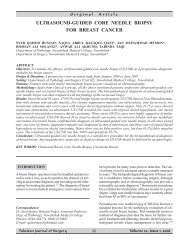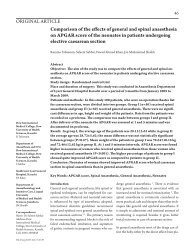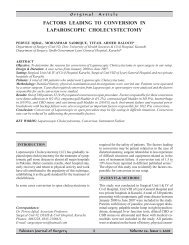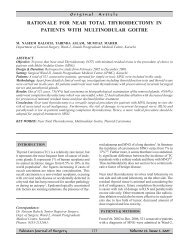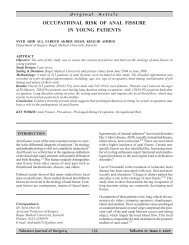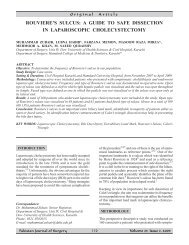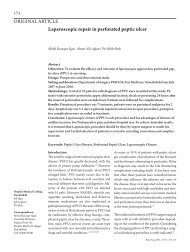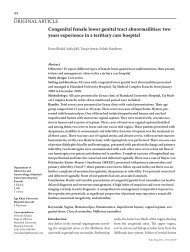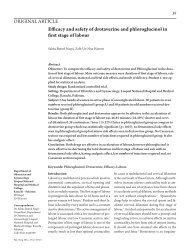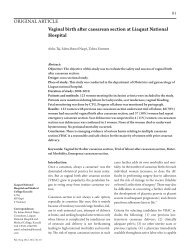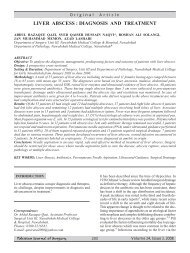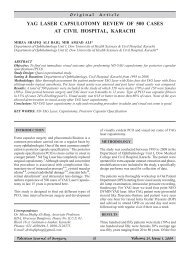Outcome of Reconstructive Procedures in Fournier's Gangrene
Outcome of Reconstructive Procedures in Fournier's Gangrene
Outcome of Reconstructive Procedures in Fournier's Gangrene
You also want an ePaper? Increase the reach of your titles
YUMPU automatically turns print PDFs into web optimized ePapers that Google loves.
<strong>Outcome</strong> <strong>of</strong> <strong>Reconstructive</strong> <strong>Procedures</strong> <strong>in</strong> Fournier’s <strong>Gangrene</strong> M. Kumar, A. R. Shaikh, et al<br />
<strong>in</strong> this study may be due to social or religious grounds.<br />
However, the low <strong>in</strong>cidence <strong>of</strong> females can also be attributed<br />
to better dra<strong>in</strong>age <strong>of</strong> the perianal region through<br />
vag<strong>in</strong>al secretions. 16<br />
All 18 patients with Fournier’s gangrene were <strong>in</strong>itially<br />
treated <strong>in</strong> the surgical ward with dress<strong>in</strong>gs, debridements<br />
and antibiotics. Once the wounds granulate and become<br />
<strong>in</strong>fection free, they were sent to the plastic surgery ward<br />
for further management. In our study no patient died<br />
due to Fournier’s gangrene though the literature mentions<br />
a mortality rate vary<strong>in</strong>g between 3-67%. 12,13<br />
In this study the cause may be decreased host resistance<br />
and ascend<strong>in</strong>g <strong>in</strong>fection from perirectal site and urethra.<br />
Diabetes is the lead<strong>in</strong>g cause <strong>of</strong> Fournier’s gangrene<br />
due to <strong>in</strong>creased propensity <strong>of</strong> tissue ischemia caused<br />
by small blood vessel disease. 14 In our study also diabetes<br />
was the ma<strong>in</strong> co-morbid condition. Pizzomo et al<br />
described an <strong>in</strong>creased <strong>in</strong>cidence (upto 50%) <strong>of</strong> Fournier’s<br />
gangrene with diabetes mellitus. 15<br />
None <strong>of</strong> the patients <strong>in</strong> our study required orchidectomy,<br />
penectomy or colostomy. Split thickness sk<strong>in</strong> graft<strong>in</strong>g<br />
was the ideal procedure <strong>in</strong> this series, which was done<br />
<strong>in</strong> 11 (61.11%) cases. Stretch and expansion <strong>of</strong> residual<br />
scrotal sk<strong>in</strong> with primary closure was done <strong>in</strong> 4 (22.22%)<br />
patients; when up to 1/3rd <strong>of</strong> scrotum is <strong>in</strong>tact it can be<br />
expanded to resurface the entire scrotum. 18<br />
In this study we used the superiomedial thigh fasciocutaneous<br />
flap <strong>in</strong> 2 (11.11%) patients. The testes were<br />
burried <strong>in</strong> a pouch <strong>in</strong> the superio-medial aspect <strong>of</strong> the<br />
thigh <strong>in</strong> those patients who had complete scrotal loss<br />
follow<strong>in</strong>g Fournier’s gangrene. This flap is based on<br />
the medial circumflex artery perforators, deep external<br />
pudendal artery and anterior branch <strong>of</strong> obturator artery. 9<br />
It is a safe and s<strong>in</strong>gle stage procedure with good aesthetic<br />
results and provides sensory coverage because <strong>of</strong> genital<br />
branch <strong>of</strong> genit<strong>of</strong>emoral nerve and ilio<strong>in</strong>gu<strong>in</strong>al nerve. 16<br />
The musculocutaneous flap was not utilized <strong>in</strong> our<br />
study.<br />
Six (33.33%) cases out <strong>of</strong> 18 had partial and 5.55%<br />
complete sk<strong>in</strong> loss. The latter was seen <strong>in</strong> one diabetic<br />
patient who was re-grafted after one week. Sk<strong>in</strong> graft<strong>in</strong>g<br />
was found to be a technically easy option with satisfactory<br />
cosmetic and functional results. 6 Hyperbaric oxygen<br />
therapy was not done <strong>in</strong> this study though it has a vital<br />
role <strong>in</strong> the management. 15,17<br />
CONCLUSION<br />
Split thickness sk<strong>in</strong> graft<strong>in</strong>g is an ideal procedure for<br />
genital area resurfac<strong>in</strong>g; primary closure <strong>of</strong> scrotum by<br />
120<br />
stretch<strong>in</strong>g and expand<strong>in</strong>g should be used when up to<br />
1/3rd <strong>of</strong> the residual scrotum is available. Superiomedial<br />
thigh flap is reliable with less complication as comparative<br />
to other flaps. Partial thickness sk<strong>in</strong> loss is the<br />
common complication <strong>of</strong> sk<strong>in</strong> graft<strong>in</strong>g.<br />
REFERENCES<br />
1. Klic A, Aksoy Y, Klic A. Fournier’s gangrene: Etiology,<br />
treatment and complication. Ann Plastic Surg<br />
2001; 47: 523.<br />
2. Xeropotamos NS, Nousias VE, Kappas AM. Fournier’s<br />
gangrene: Diagnostic approach and therapeutic<br />
challenge. Eur J Surg 2002; 168: 91-95.<br />
3. Shaikh AR. Fournier’s gangrene - urological emergency.<br />
J Surg Pak 1999; 4(1):22-4.<br />
4. Morpurgo E, Galanduck S. Fournier’s gangrene.<br />
Surg Cl N America 2002; 82: 1213-24.<br />
5. Spirnak JP, Resnick MI, Hampel N, Persky L. Fournier’s<br />
gangrene: Report <strong>of</strong> 20 patients. J Uro 1984;<br />
131: 289-91.<br />
6. Magu<strong>in</strong>a P, Palmieri TL, Green-Halgh DG. Split<br />
thickness sk<strong>in</strong> graft<strong>in</strong>g for re-creation <strong>of</strong> scrotum<br />
follow<strong>in</strong>g Fournier gangrene. Burns 2004 Aug;<br />
30(5): 505.<br />
7. Cannistrac, Kirsch-Noir F, Delmasv, Marmus JP,<br />
Boccon-Gibod L. Scrotal reconstruction by <strong>in</strong>gu<strong>in</strong>al<br />
flap after Fournier’s gangrene. Prog Urol 2003 Sep;<br />
13(4): 703-6.<br />
8. Atik B, Tan O, Ceylan K, Etlik O, Demir C. Reconstruction<br />
<strong>of</strong> wide scrotal defect us<strong>in</strong>g suprath<strong>in</strong> gro<strong>in</strong><br />
flap. Urology 2006 Aug; 68(2): 419-22.<br />
9. Hallock GG. Scrotal reconstruction follow<strong>in</strong>g Fournier’s<br />
gangrene us<strong>in</strong>g the medial circumflex artery<br />
flap. Ann Plast Surg 2006 Sep; 57(3): 333.<br />
10. Sretenoric N, Colic M, Lazic R, Bosic S, Stojad<strong>in</strong>ovic<br />
N. Fournier’s gangrene and reconstruction <strong>of</strong><br />
it defects. Acta chirlugosl 2006; 53(3): 95-9.<br />
11. Korkut M, Icoz G, Dayangac M, et al. <strong>Outcome</strong><br />
analysis <strong>in</strong> patients with Fournier’s gangrene, report<br />
<strong>of</strong> 45 cases. Dis Colon Rectum 2003 May; 46(5):<br />
649-52.<br />
12. Hejase M, Simor<strong>in</strong> JE, Bihrle R, Coogar CL. Genital<br />
Fournier’s gangrene: experience with 38 patients.<br />
Volume 24, Issue 2, 2008



